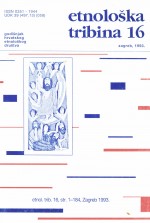Hrvatski korizmeno-uskrsni običaji u svjetlu teorije rituala prijelaza
Croatian Lenten and Easter Rituals in the Light of the Theory of Rites of Passage
Author(s): Jasna Čapo ŽmegačSubject(s): Christian Theology and Religion, Customs / Folklore, Cultural Anthropology / Ethnology
Published by: Hrvatsko etnološko društvo
Keywords: Croatia; Easter; tradition; ethnography; rites of passage;
Summary/Abstract: The author proposes to interpret the rich corpus of Croatian historical ethnographic data concerning the so-called “Easter cycle of customs” in the light of one of the most widely exploited theories in the study of ritual - the theory of rite of passage. It was originally expounded by Arnold van Gennep, who only in passage mentioned that the Jewish Pesa’h had elements of a rite of passage. The first problem encountered by the author is that the anthropological literature has virtually no studies of Easter rituals on their own. But since it abounds in studies of other rites of passage these gave the necessary theoretical background for the present analysis. The author’s main contribution thus lies in interpreting in the new light the data which pertain to the end of the 19th and the first half of the 20th century, rearranging them and pointing to their, at least in Croatian ethnology, until now unperceived structural relations. At the same time, in her interpretation of Easter the author encompasses the entire period which precedes it (Lent), pointing thus to their inseparability. The theoretical bases for the study are derived from the work of Arnold van Gennep and Jean Cazeneuve who significantly elaborated the original thesis, from the work of Edmund Leach on human perception of time and that of Pierrre Gordon on ritual as transition from profane to sacred state. They all provide the basis for interpreting rituals related to Lent and Easter as rituals of religious consecration by which man becomes part of the sacred world and in which an archetipical event is commemorated - the resurrection of Jesus Christ Lenten and Easter rituals owe their transitional characteristics both to their pre-Christian elements and to Christian rituals which overlaid them. Christianity is deeply entrenched in all preceding religious forms; its novelty lies in that it gives new content to older forms. In older agrarian rituals re-birth was primarily the renewal of nature, in Christian Easter it is primarily the renewal of man. The author recognizes both meanings in Lenten and Easter rituals as they were celebrated in Croatia at the bun of the 20th cent and up to World War II. Lent as the transitional period is so elaborated to become independent and duplicate the scheme of the ceremonial whole (cf. van Gennep) Camival-Lent-Easter. In other words, it contains both rituals of separation from the previous phase (Carnival), rites of incorporation into next phase (Easter), and a transitional period with well defined rules of behavior. Separation acts consist in cleansing houses and villages, changing outfit; transitional ones encompass special menus (no meat), proscription of entertainment of all sorts (music, dancing, wedding), an inflation of devotions, etc. By the end of Lent these acts are intensified culminating on Holy Thursday, Friday and Saturday with fasting, grief, mortification, silence, etc. Holy Saturday exhibits further acts of preparation by cleansing (with fire and water in various forms - in running water, in water in which spring flowers or egg shells were immersed), and others which incorporate men into Easter (changing outfit, making noise, preparation of special foods). The incorporation culminates on Easter with ritual taking of blessed foods prepared on the symbolically renewed domestic fire and with the reinforcement of social relations in the week after Easter through visits, exchanging eggs, games with eggs, dancing and singing meetings. The life is renewed in all respects, literally and symbolically: hearths, houses, plants (Palm Sunday ritual) and people in contact with water, plants and eggs. All events underlie the dying of the old and the birth of a new life.
Journal: Etnološka tribina : Godišnjak Hrvatskog etnološkog društva
- Issue Year: 23/1993
- Issue No: 16
- Page Range: 75-112
- Page Count: 38
- Language: Croatian

